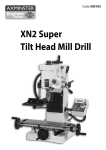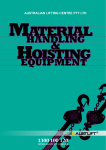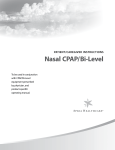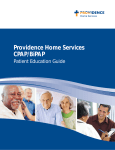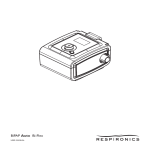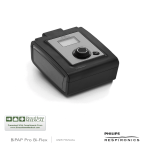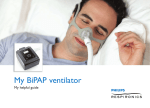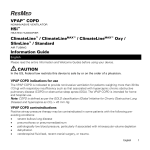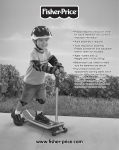Download Positive Pressure Therapy
Transcript
Positive Pressure Therapy Positive Pressure Therapy . . . . . . . . . . . . . . . . . . . . . . . . . . . . . . . . . . . . . . . . . . . . . . . . . . . . . . . . 2 What is Sleep Apnea? . . . . . . . . . . . . . . . . . . . . . . . . . . . . . . . . . . . . . . . . . . . . . . . . . . . . . . . . . . 2 Positive Pressure Machines . . . . . . . . . . . . . . . . . . . . . . . . . . . . . . . . . . . . . . . . . . . . . . . . . . . . . 4 Types . . . . . . . . . . . . . . . . . . . . . . . . . . . . . . . . . . . . . . . . . . . . . . . . . . . . . . . . . . . . . . . . . . . . . . . . . . . . . . . . . . 4 Included with Machine . . . . . . . . . . . . . . . . . . . . . . . . . . . . . . . . . . . . . . . . . . . . . . . . . . . . . . . . . 4 Interface “Mask” . . . . . . . . . . . . . . . . . . . . . . . . . . . . . . . . . . . . . . . . . . . . . . . . . . . . . . . . . . . . . . . . . . 5 Setting Up Your Equipment . . . . . . . . . . . . . . . . . . . . . . . . . . . . . . . . . . . . . . . . . . . . . . . . . . . . . . 6 Humidifier . . . . . . . . . . . . . . . . . . . . . . . . . . . . . . . . . . . . . . . . . . . . . . . . . . . . . . . . . . . . . . . . . . . . . . . . . . . . . . . 6 Tips . . . . . . . . . . . . . . . . . . . . . . . . . . . . . . . . . . . . . . . . . . . . . . . . . . . . . . . . . . . . . . . . . . . . . . . . . . . . . . . . . . . . . . . . 7 Cleaning . . . . . . . . . . . . . . . . . . . . . . . . . . . . . . . . . . . . . . . . . . . . . . . . . . . . . . . . . . . . . . . . . . . . . . . . . . . . . . . . . 7 Daily . . . . . . . . . . . . . . . . . . . . . . . . . . . . . . . . . . . . . . . . . . . . . . . . . . . . . . . . . . . . . . . . . . . . . . . . . . . . . . . . . . . 7 Weekly . . . . . . . . . . . . . . . . . . . . . . . . . . . . . . . . . . . . . . . . . . . . . . . . . . . . . . . . . . . . . . . . . . . . . . . . . . . . . . . . 8 Reordering Supplies . . . . . . . . . . . . . . . . . . . . . . . . . . . . . . . . . . . . . . . . . . . . . . . . . . . . . . . . . . . . . . . . 8 Travel Tips . . . . . . . . . . . . . . . . . . . . . . . . . . . . . . . . . . . . . . . . . . . . . . . . . . . . . . . . . . . . . . . . . . . . . . . . . . . . . . . 9 Troubleshooting . . . . . . . . . . . . . . . . . . . . . . . . . . . . . . . . . . . . . . . . . . . . . . . . . . . . . . . . . . . . . . . . . . . . .10 Thank you for choosing Handi Medical Supply for your home care needs. You can reach us by calling 651-644-9770 or 800-514-9979 Positive Pressure Therapy Positive pressure therapy is ordered after an overnight sleep study has taken place. This sleep study provides your doctor or nurse practitioner with information on the quality of your sleep. Because the diagnosis of Obstructive Sleep Apnea (OSA) or Central Sleep Apnea has been made, positive pressure therapy has been prescribed for you. We are here to help you be successful with your positive pressure system. What is Obstructive Sleep Apnea? ➜ OSA is the partial closing off (obstructing) of the airway during sleep ➜ Breathing stops due to airway collapse ➜ This airway collapse prevents air from getting into the lungs ➜ When air is not getting into the lungs it causes the brain to “wake up” so you can breathe ➜ Because sleep patterns are disrupted daytime sleepiness occurs What is Central Sleep Apnea? ➜ Central Sleep Apnea occurs when the brain doesn’t send a signal that causes the lungs to breathe ➜ With Central Sleep Apnea there is no air flow and no chest movement How does positive pressure therapy treat Obstructive Sleep Apnea? ➜ Positive pressure acts as an air splint to keep the airway open ➜ Positive pressure therapy is provided by the use of a small machine which delivers the flow of air at the ordered pressure ➜ A mask is worn over the nostrils to provide the pressure to the airway ➜ A tubing connects the mask to the positive pressure machine 2 With the use of positive pressure therapy: ➜ Breathing becomes regular ➜ Snoring stops ➜ Restful and restorative sleep occurs ➜ Daytime sleepiness goes away ➜ Quality of life is improved ➜ Decreased risk of heart disease and heart attack ➜ Decreased risk of stroke and high blood pressure ➜ Motor vehicle and work accidents are reduced Obstructive Sleep Apnea • Airway collapses • Blocked air flow CPAP Therapy • Airway splinted open • Air flows freely to lungs 3 Positive Pressure Machines There are several types of machines: ➜ Continuous positive airway pressure (CPAP) This machine has one set pressure; it is most commonly ordered ➜ Bilevel pressure This machine has two set pressures: •one for inhalation (IPAP) •one for exhalation (EPAP) ➜ Bilevel pressure with a breath rate This machine is used to treat central sleep apnea. It gives two pressures and has an adjustable breath rate. The breath rate will deliver breaths if the machine detects an absence of breathing. ➜ Auto adjusting pressure This machine will automatically adjust itself to the pressure needed to keep the airway open. This machine is prescribed if the sleep study didn’t determine the pressure required to keep the airway open. Each of these machines will have: ➜ Power cord ➜ Filters (some machines have one filter, others two filters) ➜ Filter cover ➜ 6 foot tubing ➜ ON/OFF button: starts and stops the flow of air ➜ RAMP button: with the machine turned on and the ramp button pressed on - the pressure is lowered – this allows the new user to fall asleep more easily. The pressure will gradually “ramp up” to the ordered pressure ➜ User’s manual 4 The interface “mask”: ➜ Masks come in all shapes and sizes ➜ There are nasal masks that fit over the nose ➜ Masks with “pillows” that fit into or around the nostrils ➜ Full-face masks fit over the nose and mouth ➜ Oral masks fit into the mouth ➜ Combination masks fit into the mouth and into the nostrils ➜ Each of type of mask has a port for exhaling; these ports cannot be covered ➜ Headgear ➜ The headgear holds the mask in place ➜ Chin strap ➜ A chinstrap goes under the chin and is secured on top of the head. A chin strap is used, as needed, to keep the mouth closed. A Handi Medical Supply Clinician will have you try on a number of mask styles. The mask is a very important choice and we want you to be satisfied! Most insurance companies will help you to pay for new supplies every six months. 5 Setting Up Your Equipment and Supplies Always wash your mask thoroughly before its first use. Washing will remove any surface chemicals remaining after the manufacturing of the mask. ➜ Choose a flat surface on a table next to your bed ➜ Place the machine on the surface ➜ Allow for airflow around the machine’s filter ➜ Plug machine into an electrical outlet ➜ Attach 6 foot tubing to the tubing port on the machine ➜ Attach the mask to the tubing ➜ Apply mask and headgear to head ➜ Turn on the positive pressure machine ➜ If needed, press the ramp button ➜ Enjoy your sleep! Humidifier A humidifier can be added to the positive pressure machine to moisten the air. Both types of humidifiers are to be filled only with distilled water. Using tap water leaves mineral deposits in the humidifier’s chamber. There are two types of humidifiers: ➜ Cool humidifier - The airflow passes over the water and delivers humidity at room temperature ➜ Heated humidifier - The airflow passes over warm water and delivers warm humidity. A heated humidifier aids in reducing dryness and congestion. Compliance with the machine may increase when a heated humidifier is used. •A heated humidifier must be ordered by the doctor or nurse practitioner 6 Tips ➜ Have patience! It will take some time to get used to pressure therapy ➜ Practice wearing your mask – wear it while relaxing - reading the paper or watching TV ➜ Have a usual bed routine - relax before sleeping. A warm bath and/or a warm drink may help ➜ Don’t drink alcohol or caffeine prior to bedtime ➜ Block out all distracting noise ➜ Keep the room dark ➜ Use the RAMP feature of the machine ➜ Always use your machine Cleaning Daily: 1 Clean your mask with warm soapy water followed by a clear water rinse 2 Do not use antibacterial soap (it will break down the silicone in the mask) 3 Disposable cleaning cloths can be used if they are alcohol free and lanolin free (alcohol and lanolin break down the silicone on the mask) 4 Empty the water out of the humidifier and allow to air dry (bacteria thrive in a warm moist environment; always allow your supplies to dry) 7 Cleaning continued Weekly: 1 Clean your mask, headgear, tubing, humidifier, and sponge filter in warm soapy water 2 Rinse well 3 Make a solution of: •1 part white vinegar •3 parts water Soak the mask, tubing and humidifier in the vinegar solution for 30 minutes 4 Rinse well 5 Allow to air dry Reordering Supplies Medical insurance typically helps pay for new supplies every six months. Handi Medical Supply will work with your insurance company to determine if your medical insurance company will consider the items a “covered” benefit. If you wish to receive the same supplies, simply call our customer service to place the order and the items will be shipped. Any order over $25.00 is free from shipping costs. Customer Service ➜ 651-644-9770 or 800-514-9979 If you wish to try on a different type of mask, call customer service and set up an appointment with a clinician. 8 Travel Tips ➜ Always take your positive pressure system with you! ➜ Use the travel bag provided ➜ Carry your equipment on board; do not check it in baggage (ask the flight attendant to store in the closet in the front of the plane) ➜ Carry an extension cord with you ➜ If you have a 3-pronged plug bring an adaptor with you ➜ If traveling by car, store in the passenger area ➜ Ask about adaptors for car travel, if needed ➜ Get a letter from your doctor or nurse practitioner stating the medical necessity of your positive pressure system; keep this letter with the machine ➜ For temporary “fixes” carry duct tape and quick-drying glue in your bag. ➜ If you are on a long flight, check with the airlines to see if they will allow you to use your machine during the flight ➜ If you are going to a country with different voltage, you may need different fuses. Check the manual that came with the machine. ➜ If you are going to high altitudes – some machines automatically compensate for this, others do not. Check the manual that came with the machine. ➜ Have a great time! 9 Troubleshooting Mask: Uncomfortable •Adjust headgear; headgear should be snug, but not tight •Adjust mask so it is sitting properly Air leak into eyes •Adjust angle on forehead cushion (if your mask has this) •Adjust headgear •Adjust mask so it is sitting properly Redness •Mask may be on too tight, loosen headgear •If redness is from contact with material – wash mask •If redness persists, contact Handi Medical Supply at 800-514-9979 Dry nose •Use a saline nasal spray; available in liquid or gel •Use a cool or heated humidifier (heated requires an order) •Heat the water prior to putting it in your humidifier •Wrap the tubing to keep it warm •Put the tubing under the covers with you Runny nose •A runny nose is a reaction to the airflow. A prescription from your doctor or nurse practitioner may be required. Mouth discomfort •Air may be blowing out your mouth; it is important to keep your mouth closed. A chin strap can be used if this is a problem. Dentures •Some have a better mask fit when sleeping with dentures in place. 10 Machine: Does not operate •There is no power to the machine. Check the outlet (Is it controlled by a light switch? Is it plugged into a power strip?) •Unplug and re-plug the power cords The air feels •Turn the humidifier down (change of warmer than season may require this) usual •Check the filters; they may need cleaning Notes 11 2505 University Ave W., St. Paul, MN 55114 651-644-9770 or 800-514-9979 fax 651-644-0602 handimedical.com ©Handi Medical Supply, 2008 (10/08)












